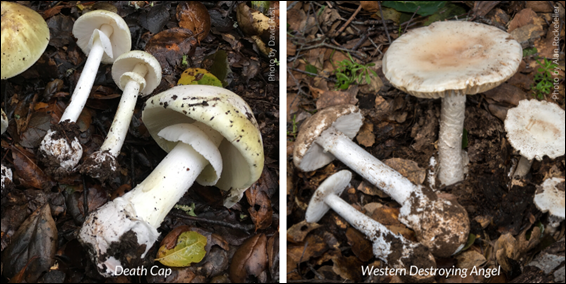During the rainy winter season, wild mushrooms pop up in great numbers throughout East Bay Regional Parks. Mushrooms are an ecologically important part of the parklands and can look beautiful—but some of them contain dangerous toxins. The death cap (Amanita phalloides) and western destroying angel (Amanita ocreata) are two of the world’s most toxic mushrooms, and both can be found in Regional Parks during the rainy season.
The death cap and western destroying angel mushrooms contain amatoxins, molecules that are deadly to many animals. Symptoms may not appear until up to 12 hours after consumption, beginning as severe gastrointestinal distress and progressing to liver and kidney failure if treatment is not sought immediately.
Both of these mushrooms can be lethal to humans and pets if consumed. Pet owners should contact a veterinarian immediately if they suspect their pet may have eaten a toxic mushroom. They are mainly associated with oak trees and can be found growing anywhere oak roots are present. Collecting any mushrooms in East Bay Regional Parks is not allowed.
The best way to stay safe is to ensure that no mushrooms are consumed by humans or pets. As an added safety measure, learn to recognize poisonous mushroom species when encountering them in Regional Parks.
The death cap is a medium to large mushroom that typically has a greenish-gray cap, white gills, a white ring around the stem, and a large white sac at the base of the stem. Although the death cap is mainly associated with oak trees, it has been found growing with other hardwoods. It was accidentally introduced to North America on the roots of European cork oaks and is now slowly colonizing the West Coast. The death cap is not native to California.
The western destroying angel is a medium to large mushroom that usually has a creamy white cap, white gills, a white ring around the stem that can disappear with age, and a thin white sac at the base. It fruits from late winter into spring. It is associated exclusively with oaks. Unlike the death cap, it is a native California mushroom.
While the death cap and western destroying angel mushrooms are responsible for most cases of mushroom poisonings in California, deadly toxins can also be found in Galerina and Lepiota mushroom species, which also occur in the Bay Area. For more information about toxic mushrooms, visit ebparks.org/safety/trails/toxic-mushrooms.
––––––––––
The East Bay Regional Park District is the largest regional park system in the nation, comprising 73 parks, 55 miles of shoreline, and over 1,330 miles of trails for hiking, biking, horseback riding, and environmental education. The Park District receives an estimated 30 million visits annually throughout Alameda and Contra Costa counties in the San Francisco Bay Area.
